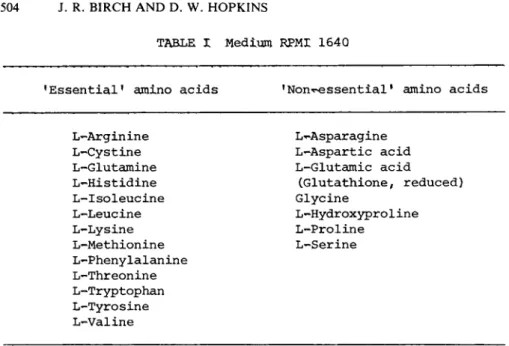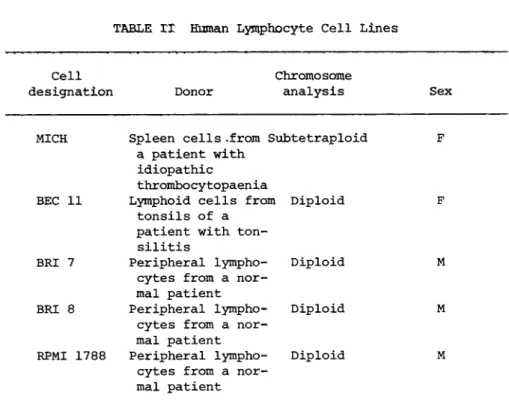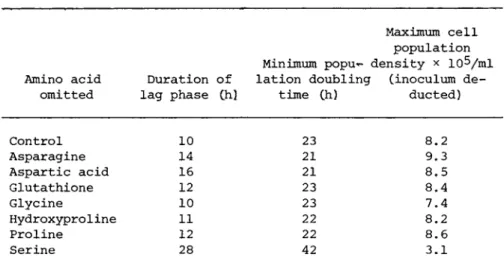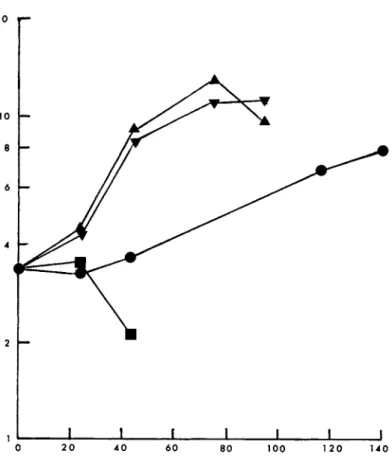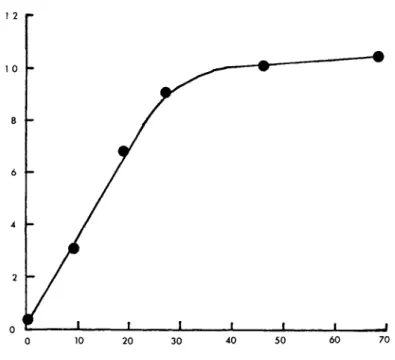OF CULTURED HUMAN LYMPHOCYTE LINES
J. R. BIRCH D. W. HOPKINS
Searle Research Laboratories High Wycombe, England
I. INTRODUCTION
Although human lymphocyte cell lines are now widely used, frequently in large quantities, surprisingly little is known about their precise qualitative and quantitative nutritional require- ments. As part of a project aimed at defining the nutrient re- quirements of lymphocyte lines, we have studied the amino acid requirements of a range of lines from normal individuals. In particular we have looked at the requirement for amino acids which are generally considered to be non-essential for cultured cells.
The culture medium most commonly used for lymphocyte culture is R.P.M.I. 1640. In addition to the 13 amino acids usually con- sidered essential for growth (Eagle, 1959), this medium contains 7 •non-essential1 amino acids as well as the tripeptide gluta- thione (Table I) .
503
'Essential1 amino acids 1 Nonessential1 amino acids
L-Arginine L-Cystine L-Glutamine L-Histidine L-Isoleucine L-Leucine L-Lysine L-Methionine L-Phenylalanine L-Threonine L-Tryptophan L-Tyrosine L-Valine
L-Asparagine L-Aspartic acid L-Glutamic acid
(Glutathione, reduced) Glycine
L-Hydroxyproline L-Proline
L-Serine
II. MATERIALS AND METHODS
A. Culture Methods
R.P.M.I. 1640 (pH 7.4) supplemented with 10% v/v dialysed foetal calf serum was used for these experiments. The medium con- tained the following modified phosphate concentrations - Na2HP04- 2H20, 500 mg/litre and NaH2P04.2H20 440 mg/litre. Trace metals were also added (3.6 μÌ FeS04.7H20, 2.0 μÌ CuS04.5H20 and 3.5 μÌ ZnS04.7H20). Cells were grown as 10 ml static cultures in 8 oz prescription bottles. Agitated cultures were grown in 10 ml medi- um in 50 ml Erlenmeyer flask shaken at 200 r.p.m.
B. Cell Types
The lymphocyte lines used and their characteristics are sum- marised in Table II.
TABLE I Medium RPMI 1640
TABLE ΓΓ Human Lymphocyte Cell Lines
Cell Chromosome
designation Donor analysis Sex
MICH Spleen cells .from Subtetraploid F a patient with
idiopathic
thrombocytopaenia
BEC 11 Lymphoid cells from Diploid F tonsils of a
patient with ton- silitis
BRI 7 Peripheral lympho- cytes from a nor- mal patient
Diploid M
BRI 8 Peripheral lympho- cytes from a nor- mal patient
Diploid M
RPMI 1788 Peripheral lympho- cytes from a nor- mal patient
Diploid M
C. Cell Counting
Growth was measured as viable cell count on a haemocytometer slide, using nigrosin (50 mg/100 ml phosphate buffered saline) to stain non-viable cells.
III. RESULTS
A. Omission of Individual 'Non-Essential1 Amino Acids
The effect of omitting individual supposedly non-essential amino acids on the growth of MICH cells is shown in Table III.
Only serine had a significant effect on growth. In its absence the duration of the lag phase was increased, the population doubl- ing time was increased and the maximum population density was de- creased. Omission of glutamic acid (not shown in Table III) and
TABLE III Effect of ' Non-Essential1 Amino Acids on Growth, of Cultured Human Lymphocytes (MICH)
Maximum cell population Minimum popu- density * 10^/ml Amino acid Duration of lation doubling Cinoculum de-
omitted lag phase Ch) time Ch) ducted)
Control 10 23 8.2
Asparagine 14 21 9.3
Aspartic acid 16 21 8.5
Glutathione 12 23 8.4
Glycine 10 23 7.4
Hydroxyproline 11 22 8.2
Proline 12 22 8.6
Serine 28 42 3.1
the whole group of 'non-essential1 amino acids other than serine had no effect on growth of MICH.
B. Effect of Glycine on Serine Requirement
If glycine was omitted from the culture medium the requirement of MICH for serine was absolute. This is shown in Fig. 1. In the presence of glycine alone growth rates were reduced. Glycine was
slightly stimulatory even in the presence of serine. Interesting- ly, in agitated culture as opposed to static culture, there was no growth with glycine alone. This may indicate that the cells are leaky to glycine as suggested by Lockhart and Eagle (1959).
Cell lines BRI 8 and BEC 11 gave essentially the same results as MICH.
C Results With Other Cell Lines
Other cell lines differed in their response to glycine and serine. Cell line R.P.M.I. 1788 did not grow in the absence of serine even when glycine was present (Fig. 2}, As with MICH
FIGURE 1 Effect of glycine and serine on growth of human lymphocytes (MICH). Abscissa, incubation period (h). Ordinate, viable cells/ml χ 105. , 1640 without glycine and serine; m, 0.13 mM glycine; T , 0.29 mM serine; k, 0.13 mM glycine + 0.29 mM serine.
growth rate and maximum population density were slightly in- creased when glycine was added to medium already containing serine.
A third type of response is shown in Fig. 3 for cell line BRI 7. This cell line grew slowly even in the complete absence of serine. Glycine increased growth rate and maximum population density.
FIGURE 2 Effect of glycine and serine on growth of human lymphocytes (RPMI 1788). Abscissa, incubation period (h). Ordi- nate, viable cells/ml χ 105. m, 1640 without glycine and serine;
·, 0.13 mM glycine; T , 0.29 mM serine; k, 0.13 mM glycine + 0.29 mM serine.
D. Quantitative Serine Requirement
The quantitative requirement of MICH for serine in the ab- sence of glycine was determined. Figure 4 shows the influence of serine concentration on maximum population density. From the slope of this graph the growth yield coefficient (amount of cell produced per unit weight of nutrient! is 0,35 x 10^ cells/yg
serine. Growth rates as opposed to maximum population densities were not influenced by serine concentrations in the range 10-
2 0 r-
2 Ο
1 0 h
8
6
4
2 Ο 2 0 4 0 6 0 8 0 100 120
FIGURE 3 Effect of glycine and serine on growth of human lymphocytes (BR17). Abscissa, incubation period (h). Ordinate, viable cells/ml x 105. •, 1640 without glycine and serine; ·, 1.3 mM glycine; ?, 0.29 mM serine; k, 0.13 mM glycine + 0.29 mM serine.
100 yg/ml but were reduced at concentrations below 10 yg/ml. The normal serine concentration of 30 yg/ml would be close to a growth limiting level in the absence of glycine. However, glycine had a marked sparing effect on the quantitative requirement and in the presence of glycine 2.5 yg serine/ml was sufficient to restore growth rates and maximum population densities to the normal levels.
IV. DISCUSSION
With certain exceptions, serine has been considered non-es- sential except at low cell concentrations CEagle, 1959). However,
1 2 r
1 0
8
ü
4
2
0
0 10 20 30 40 50 60 70
FIGURE 4 Effect of serine concentration on growth of human lymphocytes (MICH). Abscissa, serine concentration in culture medium (\ig/ml) . Ordinate, maximum cell population/ml χ 10$.
a requirement has been shown for short-term cultures of normal and leukaemic blood cells and phytohaemagglutinin stimulated nor- mal peripheral blood lymphocytes (Regan et al., 1973). These re- quirements were shown to be due to reduced enzyme levels in the
'phosphorylated pathway' for serine biosynthesis (Pizer and Regan 1972). We assume that a similar enzyme deficiency may account for the serine requirement of our permanent cell lines. The sparing action of glycine is not surprising since the amino acids are in- terconvertible through the action of serine transhydroxymethylase
(L-Serine: tetrahydrofolate 5, 10-hydroxymethyltransferase E.C.2.
1.2.1.). The varying responses of different cell lines may re- flect variations in the level of this enzyme and of the enzymes of serine biosynthesis. This may prove to be of value in the biochemical 'finger-printing' of cell lines. Ultimately studies of the nutritional requirements of cells isolated from various
sources may be useful in designing chemotherapeutic agents aimed at inhibiting specific cell populations in vivo (pubrow; et al., 1973} .
REFERENCES
Dubrow, R.r Pizer, L. I. and Brody, J. I. (1973), j . Nat, Cancer Inst, 51, 307-311.
Eagle, H. (1959). Science 130, 432-437.
Lockhart, R. Z. Jr. and Eagle (1959). Science 129, 252.
Pizer, L. I. and Regan, J. D. (1972). J. Nat, Cancer Inst, 48, 1897-1900.
Regan, J. D., Vodopick, H., Takeda, S., Lee, W. H. and Faukon, F.
M. (1969). Science 163, 1452-1453.
